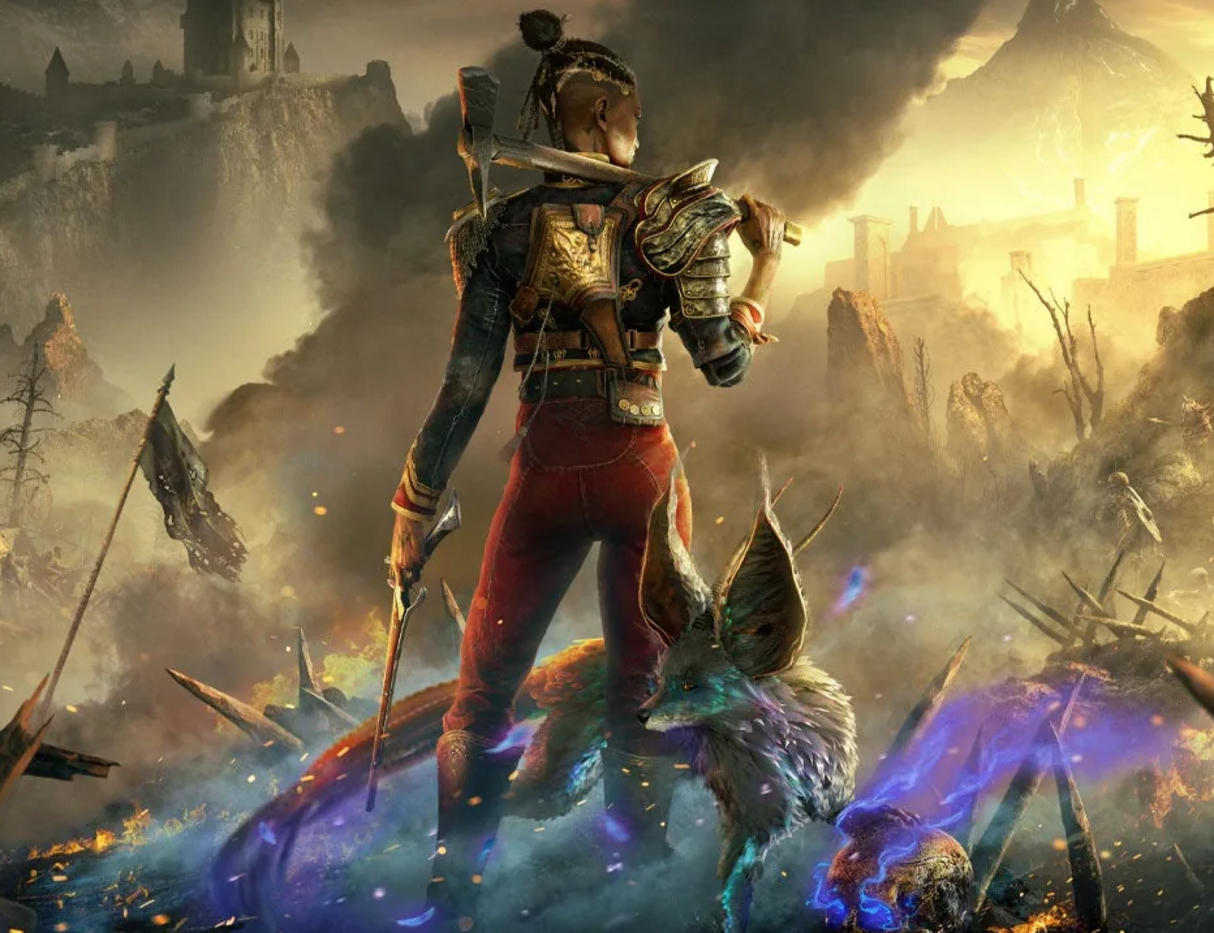Flintlock: The Siege of Dawn has been marketed as a souls-lite rather than the more common souls-like, which I assumed meant it would be more approachable while still retaining many of the genre’s core tenets. This is partly true in that it’s nowhere near as punishing as From Software’s games, and features familiar elements like bonfire-esque checkpoints and an Estus Flask-style healing system. Yet the game’s style is more akin to something like Star Wars: Jedi Survivor than any Dark Souls game. Flintlock feels like a mashup of sensibilities between a souls-like and a more traditional action game, bridging the gap between the two with its own delightful approach to fast-paced combat and high-flying traversal.
One area in which Flintlock immediately stands out amongst its contemporaries is its unique setting. Mixing magical high fantasy with elements from the 17th to 19th century and the advent of gunpowder, Flintlock’s world is immediately intriguing. For your part, you’re strapped into the boots of protagonist Nor Vanek, a sapper in the Coalition army who unwittingly breaks a seal to the Great Below, unleashing malevolent Gods and their armies of the dead upon the lands of Kian. This act sets in motion a fairly straightforward story as Nor–wracked with guilt over condemning her home to near-annihilation–sets out on a path of vengeance to kill the Gods and retake the world. She’s joined by a mysterious fox-like companion called Enki, who’s keen to share his knowledge of the Gods while aiding Nor’s efforts with a host of magical abilities.
The narrative’s simple, laser-focused approach works in the game’s favor, giving you a clear end goal to pursue that aligns with the snappy pacing of its action and movement. There are moments of interpersonal conflict, but the story never deviates from its deicidal path, lending the narrative a purposeful sense of forward momentum that carries it through to the end. The trade-off, however, is that you’re unlikely to feel any attachment to its small cast of one-dimensional characters, despite enjoyable performances from Olive Gray (Halo), Alistar Petrie (Sex Education), and Elias Toufexis (Deus Ex: Mankind Divided).
I also wish there was more to its anomalous world, which is only intriguing at first glance. Moments of downtime are sometimes punctuated by Enki explaining the nature of the Great Below and the role of the Gods, but no such effort is afforded to the setting and its inhabitants. The game’s environments are varied, both from a natural point of view and an architectural one–pulling influences from the likes of ancient Egypt, the Renaissance era, and the American Revolutionary War–yet it offers no explanation as to how these disparate elements came together. As a result, much of the game feels like mere set dressing. It’s possible I missed some optional conversations that cover this aspect of the game, but I know for sure it’s not upfront about it, nor is this information scattered away in hidden notes or item descriptions.
Fortunately, Flintlock’s level design is uniformly excellent. The first thing that jumps out about its locales is the sheer verticality present in almost every space. Rather than navigating through twisting labyrinths that corkscrew and fold back on themselves, you typically travel from one end of a large map to another. Along the way, there are numerous opportunities to venture off the beaten path, and you’re constantly rewarded for exploring with crucial discoveries such as upgrade materials and health-boosting shrines.
You might occasionally create a shortcut by opening up a metal gate, but for the most part, you’re finding magical portals that you can leap between with Enki’s help. Sometimes, these portals create paths backward, conjuring a different type of shortcut. Other times, they veer upwards, letting you launch into the sky and make use of the game’s verticality to traverse the environment and gain the element of surprise on enemies below. Combine this with Nor’s mobility–including double-jump and dash moves–and platforming in Flintlock is a constant delight as you rapidly hurtle over chasms and leap between rooftops. It can feel a tad floaty and weightless at times, but the game rarely demands precision platforming to the point where this becomes an issue.
For as crucial as traversing the lands of Kian is, Flintlock’s combat is its true bread and butter. Nor comes locked and loaded with a small arsenal of deadly armaments, including a melee weapon, a primary firearm like a pistol or the eponymous flintlock, and a secondary firearm such as a musket or fire-spitting flamethrower. Melee combat consists of the usual mix of light and heavy attacks, and you can dodge, block, and parry incoming strikes, too.
Some enemies will lunge at you with signposted unblockable attacks that can be sidestepped or, in a similar vein to Bloodborne’s gun-parrying, halted with a blast from your primary firearm–the catch being that you can only fire off a few of these shots before you need to recharge your black powder supply by getting in a few melee hits. This incentivizes you to play aggressively, especially when you consider Nor’s fleet-footedness and the fact you’re not restricted by a stamina meter. There’s a souls-like tinge embedded in Flintlock’s melee fisticuffs, but it’s more of a forgiving power fantasy than its peers.
Enki plays an essential role in this and the overall flow of combat. He has his own attacks that both curse enemies and build up their priming gauge. Striking enemies inflicted with the curse of death further builds this meter, and when it’s full, your foes enter a primed state that leaves them wide open to a deadly critical attack. This is particularly useful against armored and shield-wielding enemies, allowing you to remove their extra protection and connect with the fleshy bits. Enki proves helpful with some of his passive tricks, too, taunting and distracting enemies when you’re outnumbered.
Meanwhile, his ultimate-style Witherings let you unleash powerful abilities in a pinch, perhaps empowering your weapons with magical energy or summoning a storm that explodes from within. There’s often a lot going on in a single battle, but it feels intuitive and quickly becomes second nature to pepper an enemy with Enki’s attacks, parry an incoming strike with a blast from your pistol, and then transition into a combo of melee attacks before using a musket to send a small metal ball hurtling through your opponent’s skull.
More formidable and hard-hitting foes demand a level of patience and studious insight into their attack patterns, but on its normal difficulty setting, Flintlock provides the occasional challenge without ever being particularly tough. Enemy attacks are clearly telegraphed, and the timing window on counters is generous and, thus, relatively easy to pull off consistently. A hard difficulty setting is there for those craving more of a merciless challenge, while a “story” mode lowers the difficulty a notch further for anyone seeking an easier time. Although it is worth noting that the latter disables all achievements, which is an odd decision when so many other games are doing the opposite.
However you decide to play, Flintlock’s axe-slashing and pistol-shooting looks stylish and feels impactful. Stopping an enemy in its tracks with the thunderous clap of a blunderbuss is always satisfying, as is following up with a flurry of blows from an armor-piercing mallet or fire-tinged axe. There’s a sense of imprecision that occasionally rears its ugly head, whether it’s due to animations not quite lining up or the window to cancel an attack into a parry feeling too long and rigid. These aren’t deal breakers, but they are something you might need to adjust to.
In terms of progression, the currency of experience points you accrue is simply called reputation. You earn reputation with each kill, but in a unique twist on the usual formula, every successful strike, dodge, and parry you perform also adds a bonus multiplier. This sees the amount of reputation you can earn go up in increments, from 5% extra rep up to 100%. Suddenly, 500 reputation is worth 1,000 and you’re swimming in currency. It’s your choice when to cash in, too, because getting hit wipes out the multiplier completely, forcing you to bank only the lowest amount of reputation possible. Flintlock already encourages you to play on the front foot, but now you’re also incentivized to dispatch enemies as swiftly as you can without getting hit. It’s classic risk-and-reward, where each battle becomes a gamble. Even if it’s not the most challenging game, striving to achieve the perfect fight adds a degree of delectable tension to every clash of steel.
Once you’ve accumulated enough reputation, you can spend it on a skill tree that enhances your ranged, magic, and melee damage as you unlock new abilities related to each one. There are active skills like powerful charged attacks, passive skills that might improve critical attacks against armored enemies, and utility skills that can expand the window to execute a perfect reload. These abilities expand your repertoire in palpable ways, and you can also spend reputation to improve various facets of your weapons.
Weapon upgrades are fairly expensive, however, particularly if you’ve already achieved the highest rarity with one already. Upgrading another melee weapon to match the level of the axe I was already using felt superfluous when I still had ranged weapons and new skills to unlock, eating into my supply of resources and reputation. I ended up sticking with the same axe for the majority of the game as a result, and was disappointed that I couldn’t experiment with more melee weapons without impeding myself elsewhere.
Flintlock is not the kind of game where you’re going to see a ton of build variety. It’s a stripped-back action RPG, sprinkling in a few souls-like elements to a broth whose dominant flavor is hyper-mobile combat and traversal that’s never too punishing. It has its faults, from failing to expand on a setting that’s only interesting on paper to featuring a prohibitive weapon upgrade system and some imprecision in its combat. It might not sit at the forefront of your mind for long after the credits have rolled, but in the moment, Flintlock: The Siege of Dawn is a rip-roaring good time that’s likely to appeal to both newcomers and hardened Souls’ fans alike. Hopefully more games take some cues from its uncommon approach.

